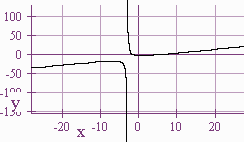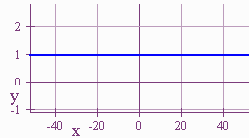3.5: Rational Functions
( \newcommand{\kernel}{\mathrm{null}\,}\)
1. Rational Functions (Definition)
is a quotient of polynomials P(x)Q(x).
are all Rational Functions
{x|x is not 1 or −1}.
2. Vertical Asymptotes
of a rational function occurs where the denominator is 0.
f(x)→∞.
Four Types of Vertical Asymptotes
Below are the four types of vertical asymptotes:




3. Horizontal Asymptotes
and we have the the left and right behavior of the graph is a horizontal line y=3.
4. Oblique Asymptotes
Consider the function
f(x)=(x2−3x−4)(x+3)

f(x) does not have a horizontal asymptote, since
x2x=x
is not a constant, but we see (on the calculator) that the left and right behavior of the curve is like a line. Our goal is to find the equation of this line.
We use synthetic division to see that
(x2−3x−4)(x+3)=x−6+14(x+3).
For very large x,
14x+3
is very small, hence f(x) is approximately equal to
x−6
on the far left and far right of the graph. We call this line an Oblique Asymptote.
To graph, we see that there is a vertical asymptote at
x=−3
with behavior:
left down and right up
The graph has x-intercepts at 4 and -1, and a y intercept at −43.
(x3+8)(x2−3x−4)
5. Rational Functions With Common Factors
Consider the graph of
y=x−1x−1

What is wrong with the picture? When
f(x)=g(x)(x−r)h(x)(x−r)
with neither g(r) nor h(r) zero, the graph will have a hole at x=r. We call this hole a removable discontinuity.
at (2,2).
We end our discussion with a list of steps for graphing rational functions.
Steps in graphing rational functions:
- Step 1 Plug in x=0 to find the y-intercept
- Step 2 Factor the numerator and denominator. Cancel any common factors remember to put in the appropriate holes if necessary.
- Step 3 Set the numerator = 0 to find the x-intercepts
- Step 4 Set the denominator = 0 to find the vertical asymptotes. Then plug in nearby values to fine the left and right behavior of the vertical asymptotes.
- Step 5 If the degree of the numerator = degree of the denominator then the graph has a horizontal asymptote. To determine the value of the horizontal asymptote, divide the term highest power of the numerator by the term of highest power of the denominator.
- If the degree of the numerator = degree of the denominator + 1, then use polynomial or synthetic division to determine the equation of the oblique asymptote.
- Step 6 Graph it!
Larry Green (Lake Tahoe Community College)
Integrated by Justin Marshall.


